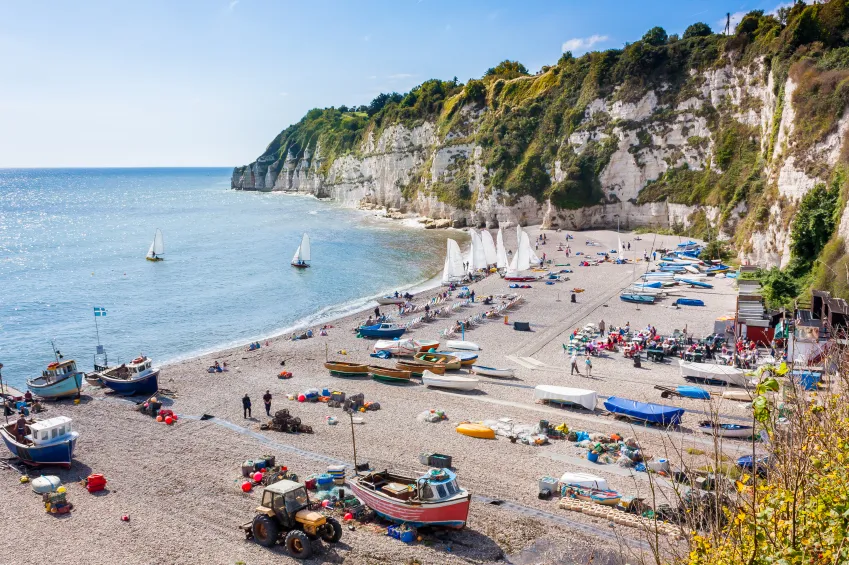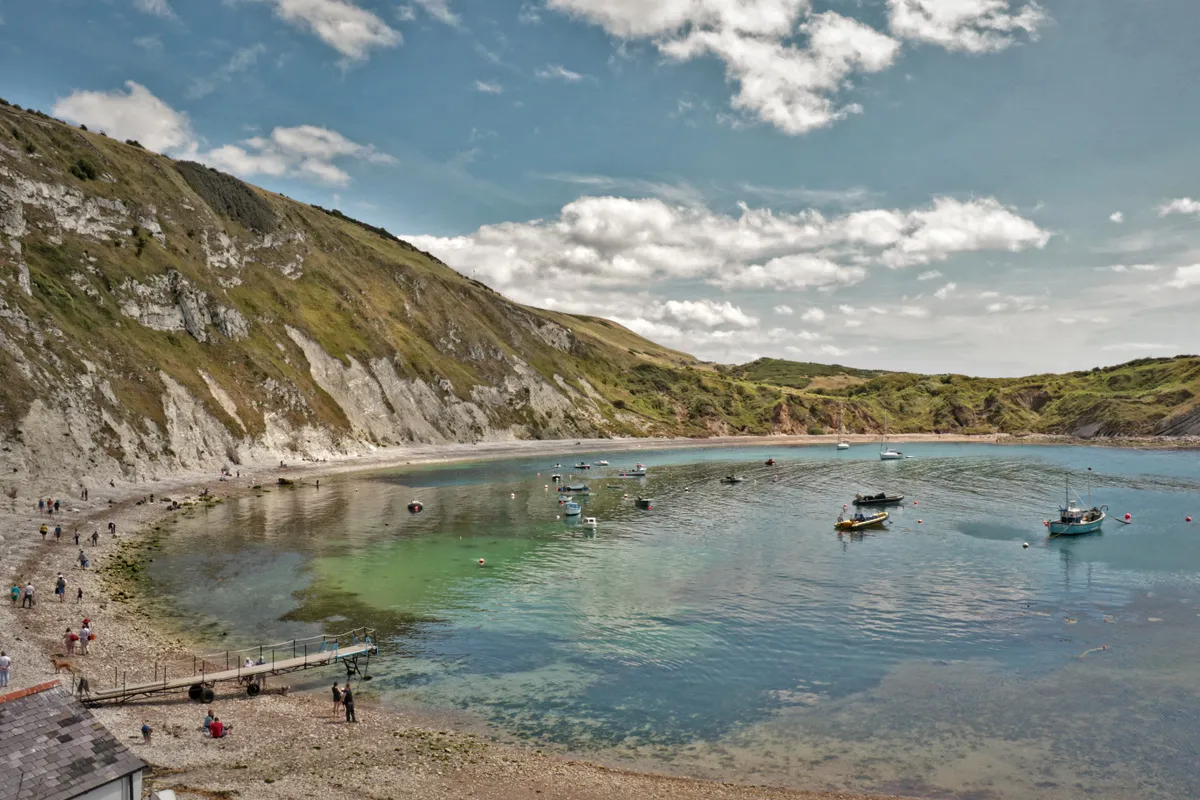The coastline of east Devon and Dorset offers something unique: in just 96 miles of colourful and varied rocky cliffs, you can time-travel through hundreds of millions of years of Earth’s history.
The rocks give us an unrivalled insight to an exciting time in the life of our planet and you don’t have to be a trained scientist to appreciate it. With a little help, anyone can decipher the evidence and look back to lost worlds filled with exotic creatures. It's this incredible geological history that resulted in the designation of the Jurassic Coast World Heritage Site in 2001.
Explore the highlights of this spectacular stretch of coastline – including where to visit, stay, eat and walk – with our expert travel guide to the Jurassic Coast.

Where is the Jurassic Coast?
The Jurassic Coast is a dramatic 95 mile stretch of coastline stretching from Exmouth, East Devon to Old Harry Rocks near Swanage, Dorset that is filled with history and fascinating geology.
What is the Jurassic Coast?
The Jurassic Coast is a fossil-hunter’s paradise, a delight for wildlife enthusiasts, and a geomorphologist’s wonderland of outstanding scenery where you can see coastal features evolving. Add to this pretty villages, industrial heritage, charming hotels and award-winning pubs and you could say the Jurassic Coast has it all.
So exceptional is the geology of the area that the Jurassic Coast was designated a natural World Heritage Site in 2001 and its official titles is now "The Dorset and East Devon Coast World Heritage Site".
Related articles

Why is it called the Jurassic Coast?
The reason is that this stretch of coastline contains rocks from the well-known Jurassic period (between 201 and 145 million years ago). In actual fact, the rocks don’t just date from the Jurassic period but span the older Triassic and younger Cretaceous geological periods, too: so really it should be called the Mesozoic coast, after the era that comprises all three.
Fossil hunting on the Jurassic Coast
One of the joys of the Jurassic coast is an afternoon spent fossil-hunting at Charmouth or Lyme Regis. It was here, in the early 19th century, that the world's first fossil expert Mary Anning made her exceptional discoveries, including the first Ichthyosaur known to science. Anning’s specimen of this marine reptile was 5.2m long.
How was the Jurassic Coast formed?
The rocks are formed from mud and clay deposited in warm Jurassic seas, and within them are the fossilised remains of ancient sea creatures. The rocks are soft and the unstable cliffs ensure a constant supply of new material onto the beach – so despite hundreds of visitors, the supply of fossils is never exhausted. With a little patience, it won’t take you long to spot the beautiful swirl of an ammonite shell in among the pebbles and experience the thrill of connecting with a creature that lived 195 million years ago.

At the Charmouth Heritage Coast Centre you can get expert advice or join a fossil-hunting guided walk and with luck, you might find a fragment of an ancient marine reptile that the area is famous for.
The most important tools you need for successful fossil hunting are a sharp pair of eyes and a bit of patience. In most places you don’t need a hammer but if you have to, use a geological hammer and wear safety goggles.
Best fossil hunting destinations in the UK
Where are the best places to find fossils on the Jurassic Coast?
Along the Jurassic Coast, the best place to find fossils is loose on the beach where the sea has already done the hard work of separating them from surrounding rocks. Cliff falls and landslides can happen without warning so stay away from all cliffs and remember to check tide tables to avoid getting cut off by a rising sea.
Lyme Regis and Charmouth
Lyme Regis and Charmouth are world-famous fossil-hunting spots and a guided walk with a local expert is a good way to get started. Don't forget to check the tide times – the best time to go is when the tide is going out, leaving the rocks freshly exposed.
Orcombe Point and Old Harry Rocks
A trip from Orcombe Point in the west to Old Harry Rocks in the east is a continuous geological journey into the Mesozoic era, from 250 to 65 million years ago. Also known as the ‘Age of Reptiles’, it was during this time that dinosaurs evolved to rule the world only to face extinction by the end. Fossil dinosaur bones are rare, but you can still see their unmistakable footprints preserved in rocks at many places including Durlston Bay and Worbarrow Bay.

Budleigh Salterton
A great place to start exploring is Budleigh Salterton, a small town close to the western end of the World Heritage Site. The beach is backed by dramatic cliffs of 250-million-year-old Triassic rocks, the oldest anywhere along the Jurassic Coast. Their deep red colour comes from iron oxide minerals that are only preserved in dry conditions. This clue tells us that back in the Triassic period, Devon was part of a hot desert, a bit akin to the Namib in southern Africa today.
Sidmouth
Carry on from Budleigh Salterton and the desert-sandstone cliffs continue eastwards. Ladram Bay is worth a visit for lovely views of isolated sea stacks that mark the former line of the retreating coast, but for old-world charm, keep going to the traditional seaside town of Sidmouth.
Try the Clock Tower Café in Connaught Gardens for some good food and a view to match looking back along the ‘Triassic Coast’ from the top of the cliffs.
As you travel east, the rocks become progressively younger. Originally laid down as sediments on top of each other, massive earth movements have tilted the ancient layers eastwards. Weathering and coastal erosion have created the landscape we see today, with the oldest Triassic exposures lying in the west, Jurassic-aged rocks generally forming a middle section and Cretaceous rocks to be seen in the east – hence the feeling of travelling through time.

Wildlife on the Jurassic Coast
It might be more famous for ancient life but the Jurassic Coast is home to some of Britain’s most exciting wildlife, too. The cliff-top grasslands are a stronghold for many species of butterfly, including the rare Lulworth skipper, which flies among the stunning displays of wildflowers in summer.
Among the varied grassland flora, keep an eye out for orchids, including the attractive green-winged orchid. If you’re feeling adventurous, try the snorkelling trail at Kimmeridge Bay for underwater wildlife such as the snakelocks anemone.

Best places to visit on the Jurassic coast
Chesil Beach
As any geography student will tell you, this is a text-book example of a tombolo, a shingle bar connecting two areas of land. Here it links the Isle of Portland to the mainland and acts as a barrier for the Fleet, the largest tidal lagoon in Britain. To find out more about this important wildlife habitat there is a visitor centre at Ferry Bridge.

Beer Quarry Caves
Beer stone has been quarried from underground tunnels just outside the village of Beer since Roman times. The unusual and extensive network of caverns at Beer Quarry Caves serves as a bat hibernaculum in winter and is open for guided tours in the summer.
Lulworth Cove and Durdle Door
As you travel east past Portland and Weymouth, you get into Cretaceous country where the youngest rocks on the Jurassic Coast make up the stunning Purbeck coastline. At Lulworth Cove, a perfect horseshoe-shaped bay has formed where the sea has broken through a barrier of hard limestone and hollowed out softer clays in front of a resistant chalk cliff.
At Durdle Door, the same limestone barrier forms a near perfect coastal arch. These, and other local sites worth exploring such as Stair Hole and the intriguing Fossil Forest, are all accessible from the coastal path.

Old Harry Rocks
The end of the Jurassic Coast is just past the headland of Ballard Down, where the famous sea stacks of Old Harry Rocks are another stunning reminder of how the sea and the underlying rocks shape the landscape.
South West Coast Path
You can explore fairly easily by road but one of the best things about the Jurassic Coast is the South West Coast Path, a national walking route that often hugs the very edge of the cliffs along its length. I’ve never walked the full extent, but dipping in and out on short sections is very rewarding.
East from Sidmouth lies the pretty village of Branscombe, with its long pebble beach. From here there is an attractive walk along the South West Coast Path for about three miles to Beer, where you can get a drink and an excellent prawn sandwich at the Anchor Inn. Along the way, after the steep slope up to South Down Common, you will encounter the slumped cliffs of the major 1789 Hooken landslide. This is a clear reminder that while the rocks may be ancient, the landscape of the Jurassic Coast is far from it. It is constantly evolving and it is this dynamism that creates such diverse habitats for wildlife.

Lyme Regis Museum
Soak up coast history with a visit to the Lyme Regis Museum. The museum is packed with displays on many themes including Mary Anning, widely regarded as one of the finest fossil collectors of all time, and the writer John Fowles, who was curator here and set his famous novel The French Lieutenant’s Woman in Lyme Regis.
Jurassic Gems
There’s a lot of choice when shopping for fossils along the Jurassic Coast, nowhere more so than Lyme Regis. Try Jurassic Gems (formerly Mike’s Minerals and Fossils), tucked away in Drakes Way. Among the real fossils, check out the wonderfully quirky knitted ammonites.
Lyme Bay Rib Charter
A boat trip along the Jurassic Coast offers a fresh perspective and is especially good for viewing the towering sandstone East Cliff at West Bay, near Bridport.
Best Jurassic Coast walks
Weymouth to Portland, Dorset
Visits a historical seaside resort and stride along the Jurassic Coast on this moderate-level walk from Weymouth train station to Church Ope Cove on the Isle of Portland. Walking route and map.

Branscombe to Beer, East Devon
If you’ve built up a thirst walking from Branscombe along Devon’s coastal cliffs and beaches to Beer, then you’re in luck – the tiny seaside village has a handful of traditional pubs, perfect for a well-earned pint. Walking route and map.

Lulworth Cove and Durdle Door, Dorset
Visit one of England’s natural wonders, then slip away from the crowds and explore the cliffs and coves beyond. Walking route and map.

Best places to eat and stay on the Jurassic Coast
A gastronomic highlight of the Jurassic Coast is lunch at the Hive Beach Café at Burton Bradstock, near Bridport. The menu of locally sourced, seasonal food includes Lyme Bay hand-dived scallops, Portland oysters and, if you’re feeling bold, try some giant spider crab, caught just off the beach.

The Lulworth Cove Inn
Pub and restaurant with 12 rooms close to the stunning cove with a quirky beach-themed décor, not to mention the roll top bath in the bedroom. Double, from £100 a night.
Book the Lulworth Cove Inn via TripAdvisor
The Seaside Boarding House
Set on the cliff top at Burton Bradstock, near Bridport. Double, from £220 a night
